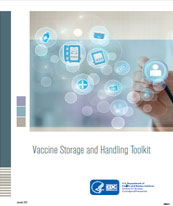What’s Been Updated in the 2020 CDC Vaccine Storage and Handling Toolkit

Earlier this month the CDC updated the “Vaccine Storage and Handling Toolkit” which seems to be an annual thing now (see the history here). The CDC Vaccine Storage and Handling Toolkit outlines the best practices for vaccine storage and handling based on the Advisory Committee on Immunization Practices (ACIP) guidelines, product information from vaccine manufacturers, and scientific studies. Supporting information, recommendations and resources are included in the toolkit. This article highlights the changes from 2019 to 2020. Please see previous reviews on our past publications page.

—Additional Resources
What is the Vaccine Storage and Handling Toolkit?
The management of valuable vaccine is one of the most important responsibilities for immunization providers. Proper vaccine storage and handling procedures and sound vaccine management practices will minimize vaccine loss and waste, and the potential need to revaccinate that could results from administering compromised vaccine. Vaccine loss is costly and the majority of the time, it is preventable.
The CDC Vaccine Storage and Handling Toolkit outlines guidance and best practices for vaccine storage and handling, which are the minimal actions required to protect your vaccine supply. All VFC providers must keep the most current version on the CDC Storage and Handling Toolkit available. The toolkit can be found at: https://www.cdc.gov/vaccines/hcp/admin/storage/.
There are many reasons for vaccine loss, including: heat and/or light exposure, inappropriate freezing, broken vials and syringes, poor reconstitution practices, possible contamination, and missing inventory. The most significant cause of vaccine loss is attributed to poor vaccine management. Vaccine management, storage, and handling procedures must include proper ordering and inventory management practices to prevent vaccine waste and ensure appropriate stock is available by funding type.
Maintaining the vaccine potency is a shared responsibility of manufacturers and clinic staff that handle the vaccine until the dose is administered. Proper storage and monitoring equipment protects patients from inadvertently receiving compromised vaccine and your facility against costs of revaccinating patients, replacing expensive vaccines, and losing patient confidence in your practice. It is the responsibility of the immunization program to offer education and guidance to providers for proper vaccine management to avoid wasted vaccine.
Each provider’s vaccine management plan and emergency response policies and procedures should be updated annually in response to CDC guidance in each of the following areas: vaccine storage and handling, vaccine ordering, vaccine borrowing, wasted vaccine, and emergency management.
What changed from last year to this year?
The 2020 edition of the Vaccine Storage and Handling Toolkit ended up being more of a clarification than it was a revision. Apart from a few graphic changes (two of which didn’t turn out quite right), the changes are:
p. 14 – In 2019 the third bullet point was “Defrost manual-defrost freezers.” This year they added “when the frost exceeds either 1 cm or the manufacturer’s suggested limit. Follow the manufacturer’s instructions. While defrosting, store vaccines temporarily in another unit with appropriate freezer temperatures.”
p. 18 – In 2019 references were made to a beyond use date (BUD). This year a statement was added: “If the vaccine has no BUD, use the expiration date provided by the manufacturer.”
p. 28 – A “Portable Vaccine Storage Unit” got defined in the glossary. On the same page, the definition of a “Qualified container and packout” was tweaked by adding “are passive containers that do not require a power souces and” to an already long sentence.
Where can you learn more about the toolkit?
What are the next steps after reading this article?
First, be sure to grab a copy of the 2020 Vaccine Storage and Handling Toolkit here. Second, explore this site and check out the latest Cool Cube™ PCM coolers. They are a type of container and pack out specifically designed for transport and emergency storage (they are passive containers that do not require a power source and are qualified to last more than 3 days at the desired temperature).
If you haven’t already, watch this 113-second explainer video to see the simplicity and effectiveness of Cool Cube™ PCM Coolers.











You must be logged in to post a comment.